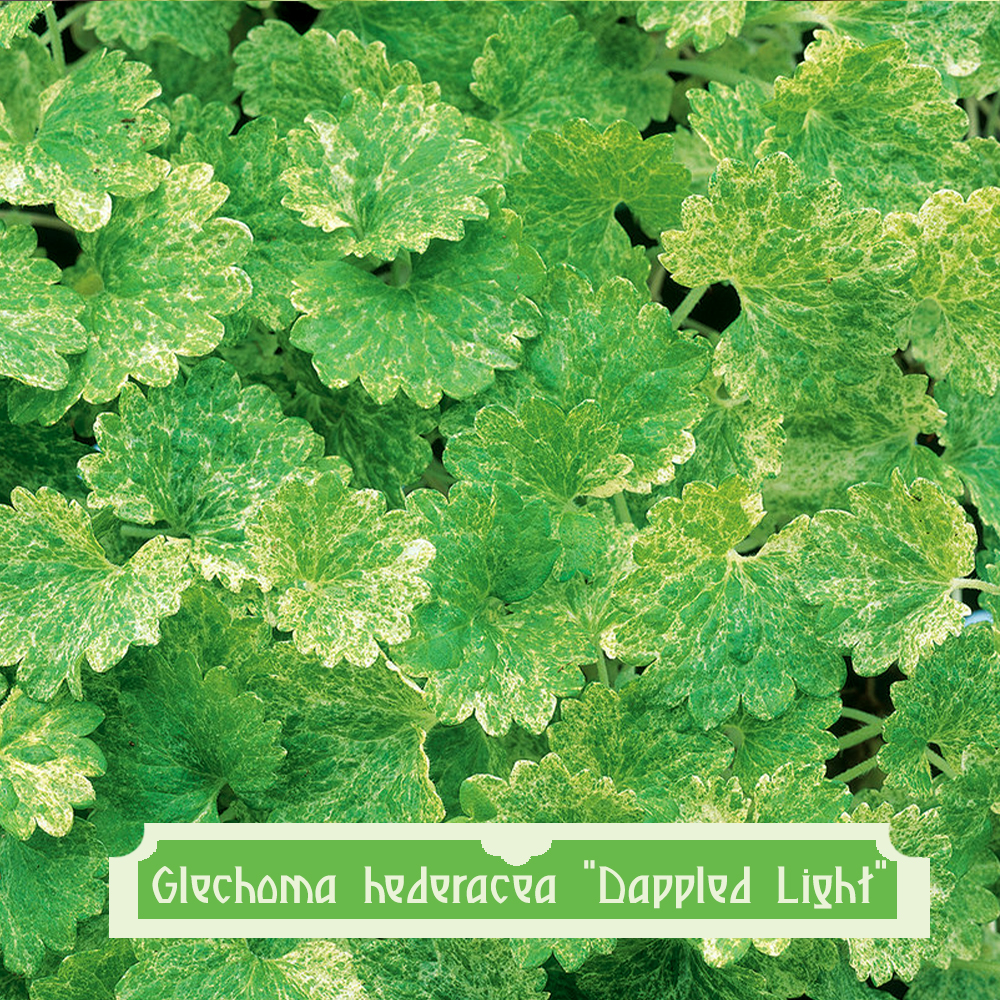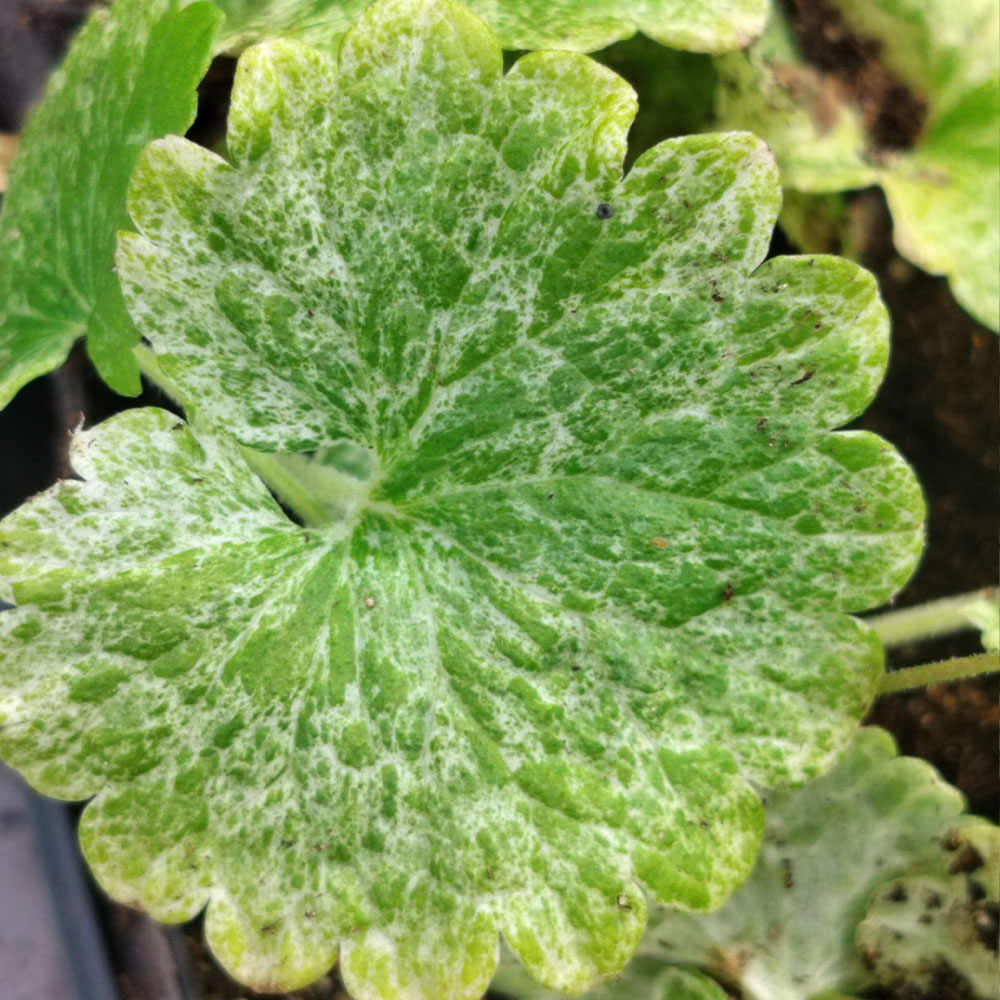No products in the cart.
Glechoma hederacea Dappled Light
A fragrant ground cover with brightly colored and unusual foliage
Rated 0 out of 5
0 customer reviews
4,90 €
Only 15 item(s) left in stock!
SKU: pda487
Category: Balcony-Friendly, Bouquet, Culinary, Evergreen, Fragrant, Frost Hardy, Ground Cover, Medicinal, Rewild, The Stunners

Glechoma hederacea Dappled Light
4,90 €
Only 15 item(s) left in stock!
Glechoma hederacea Dappled Light, known as variegated ground ivy or creeping Charlie, is a striking colored variation of the fragrant ground cover known as Creeping Charlie.
It is mainly grown for its beautiful semi-evergreen, aromatic foliage, which is particularly bright and decorative. The odor reminds me of a balsamic mixture – minty balsamic.
The leaves are semi-persistent, softly hairy, heart-shaped leaves with scalloped edges leaves. They are of an exceptionally bright white and lime green, combined with a pinkish stem. The sun brings out the pinkish-violet hues.
Its small blue flowers, reminiscent of rosemary blossoms, appear in the springtime. It is an easy-to-grow plant, just as pleasing as a groundcover as it is in pots and hanging baskets.
It thrives in almost any condition—shade, partial shade, or full sun—provided the soil is fresh and fertile.
👨🌾GARDENING TIPS👨🌾: Glechoma hederacea Dappled Light
-
- Trim back if it gets too leggy
- Looks fantastic in a pot especially paired with Carex ‘Evergold’ or Carex ‘Everest’
- 🧺 It looks incredible in a basket, where it’s cascading effect can be on full display.
Learn more about gardening with Ground Ivy:
The Tale & The Botany: Glechoma hederacea Dappled Light
Glechoma hederacea is a perennial in the Lamiaceae family, closely related to mint and thyme.
Hedera is the genus of the majority of the ivy varieties – referring to the creeping stems that root at the nodes, as an ivy does, forming dense mats of foliage that often carpet shady or moist ground.
The stems are slender and square in cross-section, a typical feature of mint-family plants.
The leaves are opposite, rounded to kidney-shaped, softly hairy, and coarsely scalloped along the edges.
They sit on long petioles and emit a pleasant, mint-like aroma when crushed.
Myths and Legends
Historically, Glechoma hederacea was used in herbal medicine as a cleansing and expectorant herb, and in medieval brewing as a flavoring and clarifying agent before hops became common.
Today, its aromatic leaves and early flowers make it valued by some gardeners as a charming groundcover, especially the variegated form Glechoma hederacea ‘Variegata’.
Extremely hardy and resilient, it remains green through much of the year and spreads wherever it finds a little moisture and shade.
European settlers transported Glechoma hederacae everywhere, as an edible and medicinal plant. It is in fact rich in essential oils, vitamin C, provitamin A, zinc, iron, silicon, molybdenum, and calcium.
However, its rapid growth rate and its rhizomatous root systems meant that it quickly colonized the areas it was was introduced to.
Glechoma hederacea is still considered invasive in several states in the United States.
Floral Morphology
From early spring to early summer, Glechoma hederacea produces small, funnel-shaped flowers of soft violet-blue to mauve, usually arranged in pairs or small clusters in the leaf axils.
Each flower has a two-lipped corolla—the upper lip short and hooded, the lower lip broad and three-lobed, marked with deeper purple veins that guide pollinators.
The flowers are arranged in groups of two to four in the leaf axils and borne on upright stems 5–30 cm tall.
The corolla is bilabiate, 1–2 cm long, with an upper lip divided into two lobes and a broader lower lip with three lobes, marked with purple spots on the upper lip.
These flowers emit a sweet fragrance that attracts pollinating insects.
The blooms are a valuable nectar source for early bees.
After flowering, the plant forms small brown nutlets (achenes) enclosed within the persistent green calyx.
Though modest in size, the plant’s creeping growth habit allows it to spread rapidly, making it both an attractive groundcover and, in lawns, a sometimes persistent weed.
Ecology
In Europe, in the wild, it grows in meadows, along roadsides, in uncultivated lands, and in deciduous woodlands.
Ground ivy thrives in shady or partially shaded places, preferring moist, fertile, well-drained soil, but it can tolerate a wide range of conditions and even survive in sun if the soil remains cool.
It has naturalized widely in North America, where it grows in woodlands, hedgerows, lawns, and along paths > more invasively than not.
Other names
Ground Ivy / Lierre Terrestre
Origin
Europe
| Weight | 0,5 kg |
|---|---|
| Flower Color | 🔵 Blue |
| Flowering | March, April |
| Soil | Cool, Clay, Clay-Silt |
| Exposure | Full Sun, Half Sun/Half Shade, Full Shade |
| Frost Tolerance | -25°C to -30°C |
| Size | 0.2m H x 0.6m W |
Reviews
0
Rated 0 out of 5
0 customer reviews
5
0
4
0
3
0
2
0
1
0
Only logged in customers who have purchased this product may leave a review.
You may also like…
Delphinium requienii
Lilac-metallic flowers on tall spires
Lilac-metallic flowers on tall spires
Rated 0 out of 5
Vinca minor
Looping elegance and ability to form a low flowering ground cover
Looping elegance and ability to form a low flowering ground cover
Rated 0 out of 5
Phlox amplifolia
A tall plant with large fragrant and edible flowers
A tall plant with large fragrant and edible flowers
Rated 0 out of 5
Glechoma hederacea
A sweet smelling ground cover, producing little blue flowers all summer long.
A sweet smelling ground cover, producing little blue flowers all summer long.
Rated 0 out of 5
Related Products
Delosperma cooperi
A dwarf perennial known for its vermillion colored flowers
A dwarf perennial known for its vermillion colored flowers
Rated 0 out of 5
Mentha x piperita ‘Chartreuse’
A spicy mint, known for its use in the production of liqueurs and herbal teas.
A spicy mint, known for its use in the production of liqueurs and herbal teas.
Rated 0 out of 5
Hieracium maculatum Leopard
A native perennial with blue-green leaves and a tall yellow flower
A native perennial with blue-green leaves and a tall yellow flower
Rated 0 out of 5
Tradescantia Blushing Bride
Gorgeous blushes of pink and white that appear in the coldest nights.
Gorgeous blushes of pink and white that appear in the coldest nights.
Rated 0 out of 5
Tanacetum densum subsp amani
A shrublet composed of soft, finely divided silvery gray-white leaves.
A shrublet composed of soft, finely divided silvery gray-white leaves.
Rated 0 out of 5
Erigeron kavinskianus
A daisy-like carpet of flowers
A daisy-like carpet of flowers
Rated 0 out of 5
Hellebore argutifolius
Winter flowering perennial with marbled blue-green leaves
Winter flowering perennial with marbled blue-green leaves
Rated 0 out of 5
Sedum album
A low, multi-color ground cover.
A low, multi-color ground cover.
Rated 0 out of 5
Stachys byzantina
Silky white-grey leaves and tall striking flowers
Silky white-grey leaves and tall striking flowers
Rated 0 out of 5
Melissa officinalis
A perennial plant in the mint family that is adored by bees, royal families and tea drinkers.
A perennial plant in the mint family that is adored by bees, royal families and tea drinkers.
Rated 0 out of 5
Cerastium tomentosum var. columnae
A grey-green spreading ground cover from the mountains.
A grey-green spreading ground cover from the mountains.
Rated 0 out of 5
Potentilla anserina
A distinctly silvery, silky and lacy perennial.
A distinctly silvery, silky and lacy perennial.
Rated 0 out of 5
Echinacea purpurea
A perennial with purple flowers all summer long
A perennial with purple flowers all summer long
Rated 0 out of 5
Kalanchoe daigremontiana
A toothy succulent from Madagascar, known as the Mother of Thousands.
A toothy succulent from Madagascar, known as the Mother of Thousands.
Rated 0 out of 5
Euphorbia myrsinites
Known for its draping form of silver-gray foliage and radiant blooms.
Known for its draping form of silver-gray foliage and radiant blooms.
Rated 0 out of 5
Trachelospermum asiaticum ‘Ogon Nishiki’
Jasmine with colorful foliage and lovely white flowers in summer
Jasmine with colorful foliage and lovely white flowers in summer
Rated 0 out of 5
Euphorbia cyparissias Clarice Howard
A Euphorbia that resembles a soft little cyprus tree
A Euphorbia that resembles a soft little cyprus tree
Rated 0 out of 5
Artemisia Valerie Finnis
A semi-evergreen, aromatic variation on the theme of Artemisia.
A semi-evergreen, aromatic variation on the theme of Artemisia.
Rated 0 out of 5
recent view product
Helenium Flammendes Katchen
A perennial with fire colored flowers all summer long
A perennial with fire colored flowers all summer long
Rated 0 out of 5
Salvia officinalis “Icterina”
A sage known for its colorful yellow and green foliage and aromatic properties.
A sage known for its colorful yellow and green foliage and aromatic properties.
Rated 0 out of 5
Delphinium requienii
Lilac-metallic flowers on tall spires
Lilac-metallic flowers on tall spires
Rated 0 out of 5
Glechoma hederacea Variegata
A ground cover known for its fragrant, unusually variegated foliage
A ground cover known for its fragrant, unusually variegated foliage
Rated 0 out of 5
Origanum vulgare Thumbles Variety
A dense cushion of golden leaves that transition to a light green hue in summer
A dense cushion of golden leaves that transition to a light green hue in summer
Rated 0 out of 5






















































There are no reviews yet.